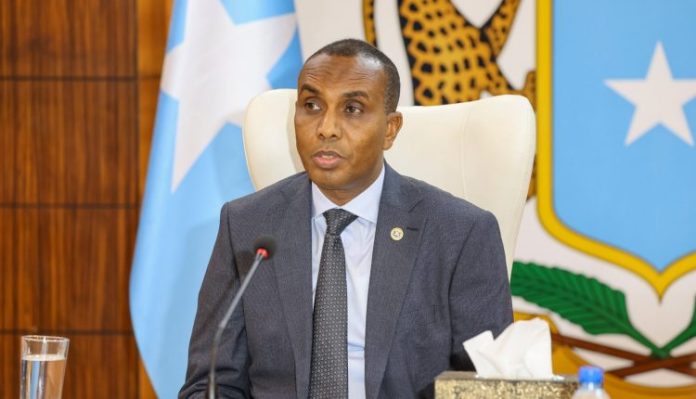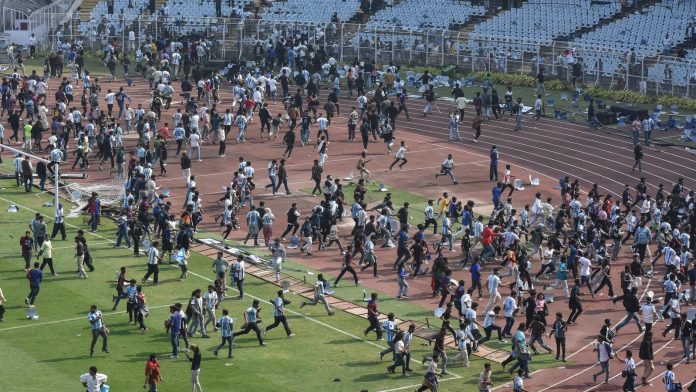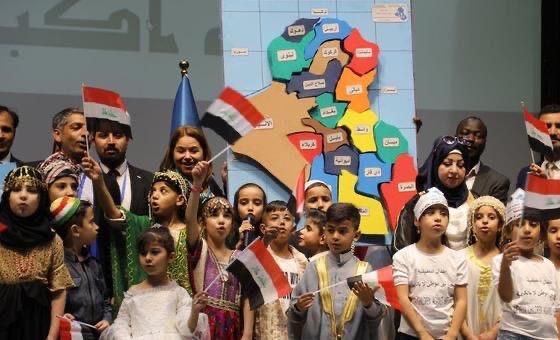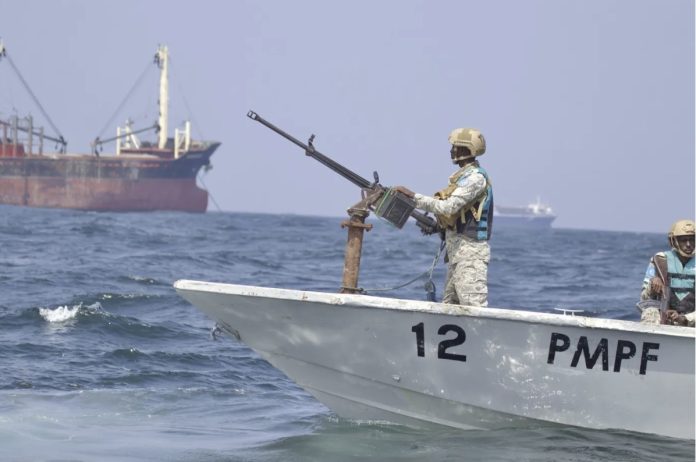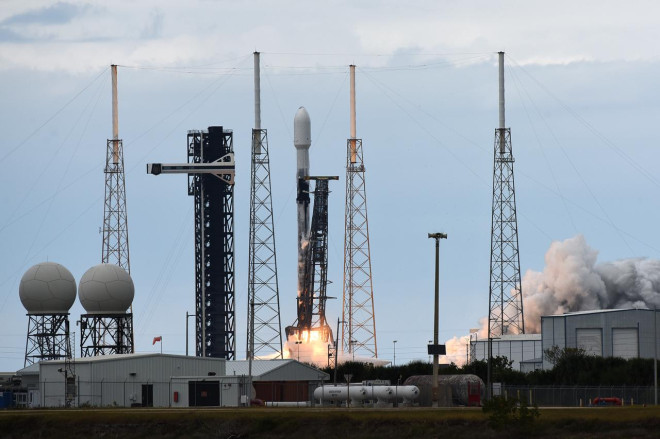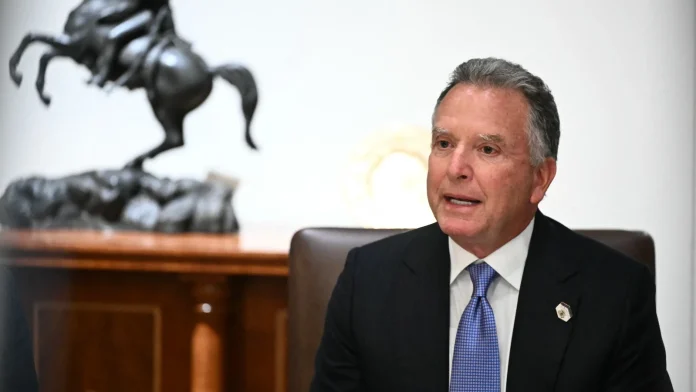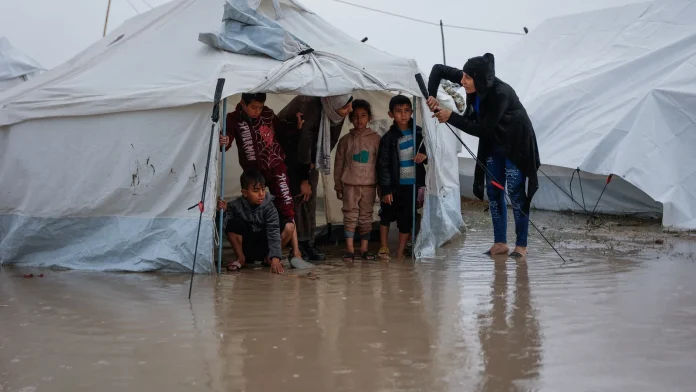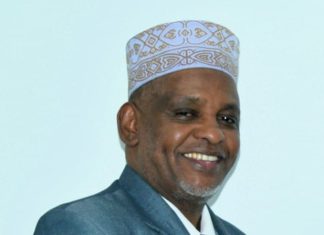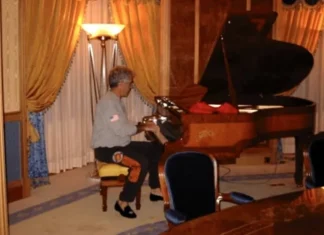Dec 13(Jowhar)-Ra’iisul Wasaaraha Xukuumadda Jamhuuriyadda Federaalka Soomaaliya, Mudane Xamsa Cabdi Barre ayaa maanta magacaabay xubno cusub oo ka mid noqon doona Golaha Wasiirrada.
Messi’s India visit erupts in chaos as fans damage stadium
When a King’s Visit Meets Kolkata’s Fever: Messi, Mayhem and a Stadium That Couldn’t Hold
It began like a carnival and ended like a cautionary tale. Dawn light poured over Salt Lake Stadium as thousands gathered, chanting and craning necks for the slightest glimpse of Lionel Messi — the man who, for many here, has become as mythic as the football gods of old. But what was meant to be a 45-minute, ticketed appearance dissolved into chaos after roughly 20 minutes. Seats were ripped loose, netting was torn from a goalpost, and people spilled onto the turf in a frenzy that felt both ecstatic and dangerous.
“I’ve been waiting my whole life to see him close up,” said Eddie Lal Hmangaihzuala, who had traveled nearly 1,500km from Mizoram and camped through two days of train journeys and buses. “I paid more than I could afford. He left so fast — I barely saw him. It felt like we were cheated of something sacred.”
The Anatomy of a Stir
The official story, as briefed by West Bengal police, is blunt: Satadru Dutta, the chief organiser, has been detained. Director General Rajeev Kumar told reporters the police had already apprehended the man they hold responsible and would pursue action so “this mismanagement does not go unpunished.” Authorities also say organizers have pledged in writing to refund ticket-holders.
Ticket prices were tiered, but even the cheaper seats — around 3,500 rupees (roughly €33) — were a significant expense for many. Some attendees said they paid far more: one fan claimed he shelled out the equivalent of €110 after navigating a secondary market. To put that in context, for many Indian households that amount represents a sizable fraction of a week’s income.
For years Salt Lake — officially the Vivekananda Yuba Bharati Krirangan — has swallowed crowds of tens of thousands. Renovations over the last decade reduced its gargantuan pre-2011 capacity, but the stadium still holds an estimated 85,000 people, making it one of Asia’s largest football arenas. That scale magnifies both the euphoria and the risk when things go wrong.
From Idol to Instigator
Messi’s presence was supposed to be a gentle celebration: concerts, youth clinics, a padel tournament, charity initiatives across Kolkata, Hyderabad, Mumbai and New Delhi. For Kolkata, there was additional nostalgia woven into the event. The city remembers Diego Maradona’s rapturous visits; the Argentine legend twice visited, and his 2017 statue unveiling remains fresh in local lore. Messi himself has a history with this stadium — he captained Argentina there in 2011 during a friendly against Venezuela, and had recently been part of a virtual unveiling of a large statue in the city.
But the adoration that draws people can also overwhelm systems not built to manage it. Chairs were torn from their anchors and hurled; fans breached perimeter fencing and stormed the pitch. “I can’t believe there was so much mismanagement,” said one local vendor who has sold tea and biscuits outside the stadium for 20 years. “When crowds move, everything becomes dangerous — the old rails, the gates, even the turnstiles. Today it felt like everything gave way.”
Faces in the Crowd: Fear, Fury, and Faith
Walk past the souvenir stalls and you hear a chorus: desperation, devotion and indignation. A young mother clutches a squirming toddler and whispers, “My son’s been playing football on the terrace — we came so he could see his hero.” An elderly man in a faded Mohun Bagan scarf shakes his head: “We love football with all our hearts, but love isn’t chaos.”
“He left quickly — I think he felt unsafe,” Eddie said, his voice hoarse. “We came here with hope. Hope felt cheap today.”
Those on the ground and watching online wondered: Who failed first — the organizers, the security planners, the ticketing agents, or the crowd itself? The answer is likely a tangle of all of them.
Systemic Shortfalls and the Business of Fandom
Sports and celebrity appearances are an industry now, and the glut of global tours has collided with local realities. Events of this scale require meticulous crowd modeling, ticketing integrity, clear ingress and egress, and contingency planning for everything from weather to sudden surges. Experts warn that when tickets trade hands in opaque secondary markets, capacity planning becomes an exercise in guesswork.
“You cannot transplant a European model of fan management and expect it to work without ground-level adaptation,” said a longtime event security consultant who requested anonymity. “Kolkata’s passion is beautiful — but when passion mixes with poor planning, you invite trouble.”
India’s sporting landscape is changing fast. Football pockets in West Bengal, Kerala and Goa remain fervent islands in a sea dominated by cricket. The commercial rush to monetize celebrity appearances — concerts, clinics, brand tie-ups — is colliding with infrastructure that sometimes lags behind ambition.
Aftershocks: Politics, Promises, and Repairs
Mamata Banerjee, West Bengal’s chief minister, publicly apologized and said she was “deeply disturbed and shocked by the mismanagement” at Salt Lake. She ordered a formal inquiry committee to investigate, assign responsibility, and recommend measures to prevent recurrence.
“We must learn from this,” she wrote on X, adding that the government would ensure refunds and accountability. Her words were meant to calm, but the visuals of ripped seats and fans standing atop the turf carried their own weight.
For Messi and his team, the incident is a PR sting at a moment when football’s global stars are expanding their reach into new markets. For India, it’s a reminder: infrastructure and governance must keep pace with cultural and commercial ambitions. When a city like Kolkata opens its arms to global icons, the embrace must be matched by systems that protect both celebration and safety.
What Now? Reflections for Fans and Organizers
Will refunds heal the reputational damage? Will the detained organizer face legal consequences that deter future mismanagement? Those are questions for the courts and committees. But deeper questions linger for all of us: how do we move from spectacle to sustainable celebration? How do cities steward the fervor that makes them unique without letting it spiral into harm?
In the lull after the storm, voices from the street still hum with hope. “If Messi comes back, we will line the streets again,” said a teenager, eyes bright under the Salt Lake floodlights. “But next time, let it be about football and joy — not tears and broken chairs.”
For now, Kolkata tends its wounds and the world watches. This was not just an event gone wrong; it was a mirror. It showed the rapture of fandom and the brittle seams of planning. It asked whether a city’s love can be celebrated with dignity — and whether, the next time, we will do better.
Hawlgalkii Qaramada Midoobay ee Ciraaq oo Albaabada loo laabay
Dec 13(Jowhar)-Kaddib in ka badan labaatan sano oo Hawlgalka Qaramada Midoobay ee Kaalmaynta Ciraaq (UNAMI) uu la shaqaynayay Ciraaq, xilli ay dalkaasi soo mareen dagaallo, qalalaase siyaasadeed iyo la-dagaallanka argagixisada ISIL, hawlgalku wuxuu si rasmi ah u joogjinayaa shaqadiisa 31-ka Diseembar.
Puntland oo gacanta ku dhigtay doon qaraxyo siday iyo Ajaanib wadatay
Dec 13(Jowhar)-Ciidamada Badda iyo Beriga Puntland ee PMPF, gaar ahaan cutubyada Badda ee degmada Eyl, ayaa gacanta ku dhigay doon siday budooyin iyo walxo kala duwan oo laga farsameeyo qaraxyada halista ah.
Newly released Epstein estate photos include images of Trump
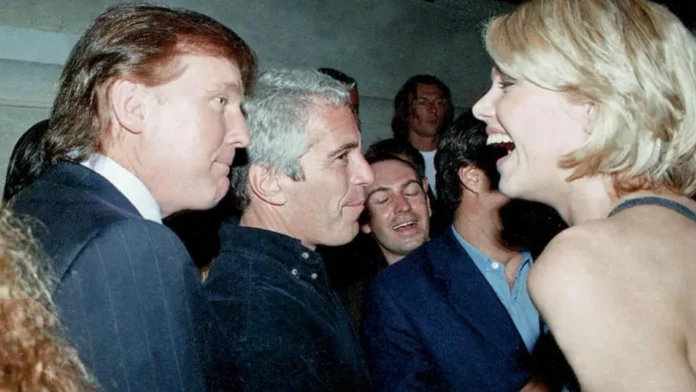
Behind the Photos: A Secret Archive Warms Under Public Scrutiny
There is a peculiar intimacy to old photographs: the way light catches a smile, the careless looseness of a tie, the tiny, private details that transform a stranger into someone almost known. Last week, a tranche of images liberated from Jeffrey Epstein’s estate landed in the public sphere—19 prints in a collection Democrats on the House Oversight Committee say is merely a sliver of more than 95,000 images now under review.
Among them: three pictures that include the face of US President Donald Trump. Black-and-white and grainy, one shows a wide grin flanked by women whose faces are redacted to protect alleged victims. Another frames Trump standing beside Epstein; a third, less clear, has him seated with a loosened red tie. There is no timestamp on these small windows. No caption to tell us what was said or when. And, to be blunt, there is no indication in these photos alone of criminal activity.
What the committee released — and what it chose to hide
The Democrats who published the images explain their editorial choices plainly: they blurred the faces of women to shield the identities of people they say were abused. That decision is, for many, proof of a caution that borders on compassion—an acknowledgement that these images are not historical curiosities but possible pieces of a survivor’s life.
- Number of images produced by the estate under review: more than 95,000
- Number of images released by House Oversight Committee Democrats: 19
- Notable individuals appearing within the released batch: former president Bill Clinton, former Trump aide Steve Bannon, Bill Gates, director Woody Allen, and former Treasury Secretary Larry Summers
- Other items in the batch: photographs of sex toys and a novelty $4.50 “Trump condom”
“These disturbing photos raise even more questions about Epstein and his relationships with some of the most powerful men in the world,” Representative Robert Garcia of California said in a statement. “We will not rest until the American people get the truth. The Department of Justice must release all the files, NOW.”
Faces, redactions, and the power of what is left out
Imagine standing in a dim room where every frame contains a story, but the central characters’ features have been inked out. It’s a strange kind of portraiture: fully revealing and deliberately withholding at once. For survivors and advocates, the redactions are necessary. For investigators and historians, they are maddening.
“You can feel the ghost of a life through these pictures,” says Elena Rivera, director of a New York-based survivors’ advocacy group who asked to be identified by her first name. “But the photos themselves are only part of a trail—metadata, timestamps, witness accounts, travel logs—that will tell us whether these were moments of social interaction or moments that facilitated harm.”
The committee’s release arrives at a high-stakes moment. Congress recently passed legislation—signed into law by President Trump, according to committee statements—that forces the Department of Justice to make unclassified Epstein-related files public within a 30-day window. The deadline, the committee notes, is fast approaching.
Why this matters beyond a set of portraits
Photographs have always had a peculiar civic power. They can humanize, scandalize, exonerate, or implicate. But their value lies not just in what they show, but in what they set in motion: questions, investigations, reforms.
Consider the broader context. Jeffrey Epstein’s death in 2019 and the murky prosecutorial decisions surrounding earlier plea deals have been the subject of public outrage, legislative action, and multiple investigations. The release of images from his estate slots into a larger narrative about accountability, privilege, and how institutions respond when high-profile wealth collides with alleged criminality.
“We are watching a test of the system,” says Daniel Chen, a legal scholar who studies accountability in white-collar crime. “Do institutions prioritize victims? Do they prioritize transparency? Or do they allow secrecy to protect the reputations of the powerful?”
Local color and the geography of influence
Epstein’s properties—Manhattan townhouses, a Palm Beach home, a private island that has since become shorthand for secrecy—are almost characters in their own right. Palm Beach gossip still carries the soft buzz of society’s upper echelons: cocktail parties with ruby lipstick, chauffeurs in crisp uniforms, and the uneasy distance between the glitter and the household staff who knew the rhythms inside.
A neighbor in Palm Beach, who asked not to be named, remembers seeing a parade of unfamiliar cars decades ago and now views the photographs through that long lens of recollection. “Back then, it was just another social season,” she says. “Now it feels like we all lived next door to a locked drawer.” Her voice cracks on the last syllable; the sentence hangs like a curtain.
Questions for readers—and for democracy
What should a democratic society do when the private lives of the powerful bleed into public harm? How much transparency is enough? And who gets to decide when privacy protects survivors or shields the guilty?
These are not rhetorical diversions. They are practical, urgent concerns. The committee says it is continuing to obtain documents even while the Justice Department prepares to release unclassified files. That bureaucratic double-act suggests both an appetite for disclosure and a recognition of the legal and ethical tightrope involved.
For many survivors, the photographs are a small solace, an outward sign that their stories have not been buried. For others, they are a reminder that justice remains unfinished.
“Photos don’t heal,” Elena Rivera says. “But they can dismantle secrecy. They can force institutions to answer. The question is whether the answers will be sufficient.”
What to watch for next
In the coming days and weeks, expect a flood of follow-up: lawyers parsing image dates and locations, prosecutors combing for corroborating evidence, advocates demanding release of travel logs and financial documents. Social media will amplify fragments; newsrooms will sift for context. The challenge will be to keep the focus on survivors and accountability, not tabloid spectacle.
And if you’re reading this from another country, where “power” plays out in different costumes and languages, think about the parallels. Secrecy and privilege are not uniquely American problems. Across the globe, transparency—or the lack of it—shapes whether institutions protect people or protect reputations.
So I ask you: when we lift the veil on these images and the files that surround them, what do we want to see revealed—not just for the sake of spectacle, but for justice, for truth, and for the quiet dignity of those whose names have been blacked out?
The photographs are only the beginning. What follows will tell us whether the light they shed is a flash in the pan or the start of something steadier: accountability made visible, and perhaps, finally, a measure of closure.
Turkiga oo Soomaaliya ka bilaabay dhismaha saldhig laga diri doono Dayax Gacmeed
Dec 13(Jowhar)-Dowladda Türkiye ayaa si rasmi ah u bilaabay dhismaha saldhigga Dayax Gacmeedka ee ay ka hirgelinayso gudaha Soomaaliya, sida uu shaaciyay Agaasimaha Tiknoolajiyada ee shirkadda Baykar Selçuk Bayraktar.
U.S. Envoy Travels to Germany to Meet Zelensky and European Leaders
A Berlin Weekend That Could Reset Europe’s Cold War of Choices
On a damp spring morning in Mitte, where the cobbled streets still remember the march of empires, an unusual delegation is arriving in Berlin. It is not just another summit of sober-suited diplomats; it is the latest, raw attempt to broker a peace for a war that has rewritten the map of Europe and the grammar of global politics.
US special envoy Steve Witkoff, appointed amid a flurry of White House diplomacy, will meet President Volodymyr Zelensky and a constellation of European leaders in the German capital this weekend. The aim, according to officials, is urgent and unnervingly complex: to push forward a US-crafted plan intended to end Russia’s full-scale invasion of Ukraine.
What’s on the Table
The United States unveiled a 28-point proposal last month that has polarized opinion across Kyiv, Washington, Brussels and Moscow. The plan has been described by critics as echoing elements of Russia’s demands — chief among them, the thorny question of territory and the notion of a demilitarised buffer in parts of eastern Ukraine.
“We’re trying to move the conversation from what divides to what secures,” said a senior Western diplomat in Berlin, speaking on condition of anonymity. “But security guarantees and territorial integrity are not interchangeable in Kyiv.”
According to reports circulating among the delegations, the updated US blueprint would include a fast-tracked path to European Union accession for Ukraine — a jaw-dropping timeline that places accession as soon as January 2027. That timeline, if true, would smash precedents: EU accession usually takes years of institutional reform and the unanimous consent of 27 member states.
Why the Accession Talk Matters
For Ukrainians, membership in the EU is both a symbol and a safeguard. It is a promise of economic integration, legal standards and a shared identity that many in Kyiv see as a rebuke to imperial designs from the east. For Brussels, it is a gargantuan administrative and political challenge.
“You don’t just sign up and inherit a rulebook,” a senior EU policy adviser told me over coffee near the Brandenburg Gate. “Accession requires deep judicial reform, anti-corruption measures, and unanimous political approval — and Hungary has been a constant spoiler on this issue.”
Indeed, Budapest’s objections have been a persistent headache. Hungary’s Prime Minister has raised concerns about minority rights, governance standards, and political leverage — and he would hold the power of a veto in any accession vote.
Security Guarantees: The Horse Before the Cart?
Beyond the optics of accession, European capitals and Kyiv are insisting on something simpler and harder to guarantee: binding security guarantees before any territorial concessions can be discussed.
“We need legally binding assurances,” Alyona Getmanchuk, Ukraine’s ambassador to NATO, said in a statement. “No meaningful negotiations can begin without them.” Her words are echoed by diplomats in Paris and Berlin, who stress that any deal must prevent future aggression and not merely paper over current hostilities.
French presidential advisors have been blunt. “Ukraine isn’t considering territorial concessions,” one aide told me. “The red lines are clear.”
Moscow’s View — Cautious, Calculated, Suspicious
From Moscow, the reception has been chilly and wary. Kremlin aide Yuri Ushakov warned that the revised plan could be “worsened” and noted that Moscow had not been formally presented with the updated version after recent talks between US envoys and President Putin. The message was not subtle: Russia wants a hand in shaping any peace architecture.
“They’re reshuffling the deck without telling us the new cards,” a Russian foreign policy analyst said. “Of course we’re suspicious.”
That suspicion is rooted in a long history of broken agreements and competing narratives. Moscow sees NATO expansion and Ukraine’s drift to the West as existential threats. Kyiv, scarred by years of occupation and displacement, sees concessions as a perilous capitulation.
On the Ground: Voices from Kyiv and Berlin
Walk through Kyiv today and you hear resilience threaded through everyday life: women shopping for sunflower oil, fathers teaching children to ride bikes along boulevards scarred by tanks. Yet there is also fatigue — a hunger for a resolution that does not hollow out the nation’s sovereignty.
“We want peace,” says Olena, a teacher in her 40s. “But not at the price of giving away our land. We fought for it.”
In Berlin, the mood is technocratic and anxious. Chancellor Friedrich Merz will host Zelensky at a German-Ukrainian business forum ahead of the leaders’ meeting. German industry — from energy firms still recalibrating away from Russian gas to defense manufacturers supplying Kyiv — has stakes in stability, not fairy-tale solutions.
“German businesses want predictability,” says a trade representative attending the forum. “They can plan investment if they see order, not perpetual uncertainty.”
The Numbers Behind the Noise
Some facts to keep in view: Russia launched its full-scale invasion of Ukraine on 24 February 2022. The conflict has displaced millions and resulted in tens of thousands of military and civilian casualties — figures that remain contested and tragically incomplete. The European Union currently has 27 member states; accession requires unanimous approval and extensive reform by the applicant country.
Meanwhile, battlefield dynamics continue to evolve. Moscow has pushed forward in some sectors; Kyiv has staged resilient defenses and launched counteroffensives when conditions convene. The human cost on both sides has been profound — friends lost, communities uprooted, economy shaken.
Questions That Will Shape the Weekend
Can the US use its diplomatic weight to nudge reluctant EU members into rapid accession talks? Can legally binding security guarantees be formalised in a way that satisfies Kyiv’s demand for sovereignty and Moscow’s thirst for buffer zones? Is there a path that saves face for each capital without forcing Ukraine to cede the very land that defines its identity?
“If we are to avoid another generation of conflict, we must be brave enough to imagine durable institutions and brave enough to live by them,” a retired NATO general told me. “But bravery without clarity is dangerous.”
Why This Matters to the World
This is not just a European drama. The choices made in Berlin will reverberate across alliances, test the limits of American influence, and set precedents for how the world deals with armed aggression in the 21st century. From Tokyo to Pretoria, governments are watching whether collective security, law and the rules-based order can be translated into enforceable reality.
So as leaders gather in conference rooms and delegates murmur in hallways, ask yourself: what kind of peace do we want? One that freezes conflict under watchtowers and buffer zones, or one that invests in a living peace — repairs institutions, lifts economies, and heals communities? The answer will shape Europe’s map and the moral calculus of an international order still learning how to keep promises.
After the Summit
Whatever emerges from the meetings in Berlin, it will require more than signatures. It will demand sustained political courage, legal craftsmanship and, above all, a willingness from all sides to imagine a future where borders are not bargaining chips and where security is shared, not imposed.
“There is no formula that fits neatly into a conference schedule,” Zelensky told reporters before departing for Berlin. “But there is an obligation — to the people who have lived through this war — to try.”
And for readers watching from afar: what would you ask the leaders who hold peace in their hands this weekend? How should the international community balance justice, security and the right of a people to their land? The answers are not simple, but they are urgent.
Britain’s King Charles has cancer treatment scaled back
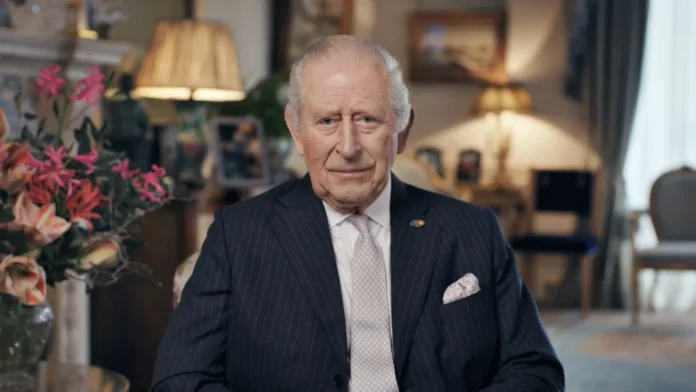
A Royal Reminder: When a Monarch’s Health Becomes Everyone’s Wake-Up Call
The flicker of a television screen, a familiar face framed against a simple backdrop, and a voice that has threaded through Britain’s public life for decades: when King Charles III stepped forward in a filmed message this week, what felt intimate carried weight. He spoke not as a distant figurehead but as someone who had sat in a hospital chair, received care, and emerged with a message he wanted to share—one that nudges at the quiet corners of our lives where fear, denial and hope mix.
“I’ve been having outpatient treatment,” he said, “but from the start the doctors and the early diagnosis made all the difference.” Those words—about scaled-back treatment, about the community of care that buoyed him—were brief, practical, human. They landed in living rooms and lunchrooms during Channel 4’s Stand Up To Cancer evening, an event that mixes comedy with urgent public health messages and fundraising for Cancer Research UK.
Why this matters beyond the palace gates
This isn’t just about one man’s calendar being freed from weekly clinic visits. It’s about what happens when a public figure describes, plainly, the pathway from diagnosis to active life. In Britain, health campaigns have long fought a battle against inertia: screening invitations ignored, symptoms explained away, appointments postponed. The King’s announcement—optimistic yet grounded—was a public nudge with the heft of visibility.
Globally, the numbers are stark. According to the International Agency for Research on Cancer (IARC), roughly 20 million new cancer cases are diagnosed worldwide each year and nearly 10 million people die annually from the disease. In the UK the long-standing estimate that around one in two people born after 1960 will be diagnosed with cancer during their lifetime is a statistical inevitability now becoming a lived reality for more and more families. Screening and early detection don’t eliminate risk, but they save lives—and they can, in many cases, turn acute crises into manageable chapters.
Voices from the clinic and the community
In the wards and corridors where this work is done, the response was quietly fierce with pride—and a little relief. “Seeing someone in his position speak openly about scaling back treatment because of early detection hits home,” said Sarah Malik, an oncology nurse at a London clinic. “That’s not theatre; that’s message: come in for the test, come back for the scan. It matters.”
At a support group in Sheffield, retired postman Tony Richards wiped his eyes as he talked about his own late diagnosis. “If I’d had a test earlier, I might have been in a different place now,” he said. “If the King’s message makes one person pick up the phone and book, that’s two lives changed—the patient’s and their family’s.”
Researchers who study behaviour change add nuance. Dr. Amina Patel, a behavioural epidemiologist, points out that single events—celebrity stories, high-profile announcements—can produce measurable bumps in screening uptake. “The so-called ‘celebrity health effect’ isn’t magic,” she notes. “It works when the infrastructure is ready: accessible appointments, clear information, and follow-up. The King’s words create motivation. Our job is to convert that into action.”
Screening: a small action, an outsized impact
Let’s speak plainly about what people can do. In the UK the major screening programmes include:
- Breast screening (mammography) offered to women and people with a cervix in their 50s—roughly every three years.
- Cervical screening (smear tests) beginning in the mid-20s through to mid-60s, with intervals depending on age and past results.
- Bowel cancer screening, typically for people aged 50–74, using home kits that check stool samples for signs of blood.
Uptake varies. In recent years about six in ten people invited to the NHS bowel screening programme took part, while breast and cervical screening participation has hovered around seven in ten—figures that have small but significant gaps along lines of income, geography and ethnicity. Those gaps are not inevitable. They are fixable.
Beyond numbers: cultural textures
There is a cultural texture to screening uptake that simple statistics don’t capture. In some communities, clinics double as hubs of trust; in others, medical appointments are viewed through the lens of work schedules, childcare or language barriers. A West London community health worker, Maria Eze, describes afternoons when she walks through a street market handing out leaflets and listening. “People will tell you they’re terrified,” she says. “But once you sit with them, explain the steps, show them it’s not an exam of character, they’ll sign up.”
The King’s tribute to nurses, specialists and volunteers in his message recognises this mosaic of care: it’s the surgeon and the GP, the lab tech, the driver who gets someone to an appointment, the volunteer who makes tea in a waiting room. Each part matters.
What the King’s announcement asks of us
There is a paradox baked into public health: the most effective actions are often the least dramatic. A test kit delivered in the mail. A booked appointment. A small injection of courage. The monarchy’s brush with illness turns these mundane acts into civic gestures—acts of care for oneself and for community resilience.
So ask yourself: when was the last time you opened one of those envelopes from your GP? Have you put off a smear, a mammogram, a simple stool test? If a televised message from a monarch can move you, imagine how much more you could do for a neighbour, a partner, a child. Screening is not a guarantee, but it is leverage—an opportunity to tip the balance.
Practical next steps
If you’re unsure where to start:
- Check your NHS letters and the eligible age ranges for screening where you live.
- Talk to your GP or local clinic about any symptoms, however small; many cancers are most treatable when found early.
- Ask community organisations for help booking or getting to appointments if transport or language is a barrier.
That the King has been able to reduce his treatment schedule is newsworthy—but the deeper story is one of systems, people and choices aligning. Behind every press release are nurses peering at scans, scientists analysing data, volunteers making calls. Behind every screening statistic is a person deciding to act.
What will you decide today? Will you make that call? Book that appointment? Encourage someone you love? In this quiet intersection between public life and private health, the answer can change more than one life.
EU Approves €3 Fee for Small Parcels Imported from Outside Bloc
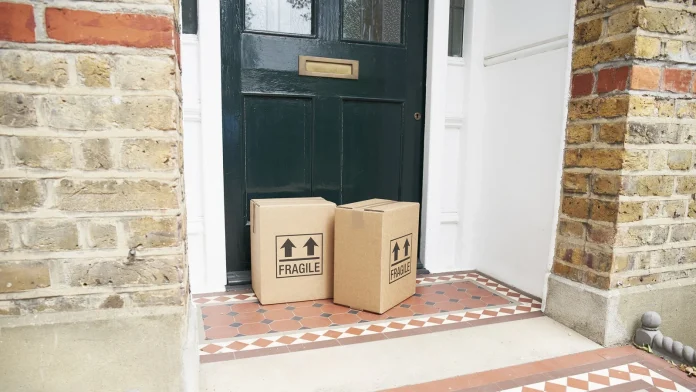
Tiny Parcels, Big Politics: The EU’s New €3 Duty and What It Means for Shoppers, Shops and Sovereignty
On a gray morning in a customs warehouse outside Rotterdam, conveyor belts hummed beneath the fluorescent lights like a mechanical heartbeat. Cardboard boxes, padded envelopes and glossy poly mailers shuffled through scanners, carrying everything from $3 hair clips to knock‑off designer sunglasses. For years, most of these parcels crossed borders with near impunity — inexpensive, direct-to-consumer wares that slipped past tariffs and landed on European doorsteps for a pittance.
That era is ending. EU finance ministers have agreed to impose a flat €3 duty on all small parcels entering the 27‑nation bloc, a measure due to take effect on 1 July next year. It’s a modest headline number — three euros — but its ripples will be felt across living rooms, high streets and trade corridors from Lisbon to Lviv.
Why three euros? A short answer with long consequences
The new fee is intended as a blunt instrument to slow a flood of cheap imports that, according to EU estimates, totalled 4.6 billion small packages last year — that’s more than 145 parcels every single second — with roughly 91% originating in China. France alone received about 800 million of those packages.
An EU spokesperson described the charge as temporary, a stopgap until a comprehensive, permanent system for taxing small imports is agreed. The move follows a separate decision to end a duty exemption for goods under €150 that were sent directly to consumers — a change designed to close what Brussels calls an “unjust advantage” enjoyed by online platforms and overseas sellers.
“Europe is taking concrete steps to protect its single market, its consumers and its sovereignty,” France’s finance minister Roland Lescure said this week, calling the flat tax “a major victory for the European Union.” That victory is political, economic and symbolic.
Voices from the street: who will feel the change?
“I used to buy a blouse on Shein for €8,” said Sophie, owner of a small boutique in Marseille. “I knew I was paying for fast fashion, but sometimes my customers simply couldn’t afford my handmade pieces. This could level the playing field — if it’s enforced properly.”
Across town, Rachid, a delivery driver, shrugged. “Three euros might not sound like much to someone with a big salary, but multiply that by thousands a day and some customers will think twice. Still, I’d rather have safer goods and fewer returns for broken batteries or unsafe toys.”
A customs officer who asked not to be named told me the daily stream of parcels has created real headaches: “They’re tiny, they come in massive numbers. Checking them all is impossible. A flat fee helps slow volumes and gives us a breathing space to inspect what matters.”
Not just retail: safety, waste and national sovereignty
European retailers — from independent bakers to multinational brands — have long argued that they face unfair competition from overseas platforms such as AliExpress, Shein and Temu. These platforms often sell directly to consumers in the EU without always observing the bloc’s product safety, environmental or labour rules, critics say.
Beyond competition, there’s a consumer‑safety argument. Reports of non‑compliant electronics, counterfeit goods and unsafe children’s products have multiplied in recent years, prompting regulators to act. Then there’s the environmental side: tiny parcels mean extra packaging, more carbon from air freight and a logistics chain that’s harder to decarbonize.
“It’s not just about tariffs,” said Dr. Elena Marković, a trade policy researcher in Brussels. “This is about governance at the digital and physical intersection. How do we regulate companies that blur national borders? How do we ensure consumer safety without strangling innovation? The EU is wrestling with these questions in public.”
How the measure will work — and the bumps ahead
The headline €3 duty is straightforward on paper: every small parcel imported into the EU will be charged that fee. It’s temporary, Brussels says, pending a permanent framework. Earlier this year the European Commission also floated a €2 small‑package handling fee intended to cover customs processing; member states are still negotiating that and hope it may take effect in late 2026.
Practical questions remain. Will the costs be absorbed by sellers, passed to consumers, or swallowed by platforms? How will platforms track and declare millions of items accurately? What about parcels routed through third‑country hubs? Implementation across 27 different tax and customs administrations will be complex, and enforcement will require investment in IT systems and manpower.
- Temporary €3 flat duty on all small parcels, starting 1 July next year.
- Duty exemption for packages under €150 has been removed (previously allowed).
- Commission proposed an additional €2 handling fee; member states hope it will apply from late 2026.
- 4.6 billion small packages entered the EU last year; 91% came from China; France received ~800 million.
Winners, losers — and the uneasy middle
Small independent retailers see this as a chance to reclaim customers and protect local jobs. Public authorities see an opportunity to tighten safety controls and recoup lost tax revenue. But low‑income consumers who have relied on ultra‑cheap imports for essentials will feel the pinch.
“I buy from those sites because I need things for the home that I can’t afford otherwise,” said Marta, a single mother in Warsaw. “If prices go up, there will be trade‑offs. We’ll have to choose between heating and a new coat.”
Meanwhile, global platforms will likely adjust business models — shifting logistics, raising prices slightly, or offering bundled shipping. They may also ramp up lobbying efforts. Trade policy watchers expect court challenges, political negotiations and one‑way or another adjustments to the fees’ technical design.
Bigger picture: what this says about globalization today
This small‑parcel story is a microcosm of larger currents reshaping the global economy. For decades, the logic of globalization celebrated frictionless flows — of goods, services and data. Now, after a pandemic that exposed supply‑chain vulnerabilities, geopolitical tensions, and a reinvigorated focus on local jobs and environmental limits, many governments are reintroducing friction intentionally.
Is that protectionism dressed up as prudence? Sometimes. Is it a legitimate defense of public standards and of an economy that works for citizens instead of platforms? Often. The answer depends on implementation and intent.
What I kept thinking as I walked through the customs hall was this: our shopping habits are not just personal choices. They are policy outcomes. They create demand, shape factories, draw shipping lanes and write the rules of commerce.
Questions for the reader
Would you be willing to pay a little more to protect local businesses and ensure safer products? Or do you value the immediate savings and convenience of ultra‑cheap imports more? How should regulators balance consumer choice, small business protection, and global trade rules?
These are choices for societies to make, not mere technicalities. Tiny parcels have become a big political issue because they sit at the intersection of everyday life and geopolitics, of taste and regulation, of environmental cost and economic access.
When the €3 fee lands next July, it will be a test — not only of customs IT systems and legislative patience, but of how Europe wants to shop, sell and govern in an age where a package no bigger than a paperback can carry the weight of international policy.
Gaza’s tent residents hit by catastrophic flooding, UNICEF warns
When the Sky Breaks: Gaza’s Displaced Children, Tents and the Turning Rain
Rain is supposed to be cleansing. In Gaza this week it has felt like an accusation.
For thousands who have already lost homes, family photographs and the little predictability war allows, a series of heavy downpours did something more practical and cruel: it turned flimsy shelter into swamp. Tents made of tarpaulin and hope—rows of them pressed up against rubble-strewn streets—filled with water, mud and cold. Children slept in damp clothes. Families who had been moved from one shelter to another, sometimes more than once, woke to find what little they had left sodden and ruined.
“We are used to the noise of bombing. We were not prepared for the sound of water,” said Zahra, a mother of three who now lives in a crowded compound in eastern Gaza City. “My boy woke up and his feet were black. There was no dry place for him to sit.”
Humanitarian reality: tents are fragile, supplies are thin
UN agencies and aid workers on the ground are sounding the alarm. The UNICEF office in the region has warned that what was already a precarious displacement crisis has become a catastrophe in places where tents and makeshift shelters line the landscape.
“We’re seeing extremely simple and fragile structures—tarps, plastic sheeting, a thin groundcover to keep out the worst of it. It is not shelter. It is still a trap,” an aid worker who has been coordinating winter relief efforts told me over a call from Gaza. “Children are sleeping wet. Hygiene is collapsing. When you mix those things you get disease.”
Recent field reports describe clogged drainage, contaminated puddles and latrines overflowing in some informal settlements. Health workers are watching for spikes in respiratory infections and waterborne illnesses; even as they try to distribute blankets and dry clothing, supplies are outpaced by need.
Numbers that matter
Rough figures underline the urgency: almost the entire population of Gaza—around two million people living in a dense coastal strip roughly 365 square kilometers in size—were already dependent on humanitarian aid during and after the fragile ceasefire that paused wider hostilities. Thousands remain displaced, crammed into makeshift camps or relatives’ homes. UNICEF and other agencies have reported that current winterization supplies, while arriving in larger volumes than months prior, are still insufficient to protect everyone at risk.
“We have sent blankets and tarps,” said one logistics official for an international NGO. “But when it rains across hundreds of sites, boxes of supplies become a trickle.” She paused. “The scale here swallows supplies.”
Personal loss, public grief
The human toll is not only material. Aid workers have reported cases of infants suffering from exposure and, tragically, the death of very young children—reports that local health workers describe as being connected to hypothermia and worsening hygiene conditions.
“I held a baby today who could not stop shivering,” recounted a pediatric nurse stationed at a community clinic. “Her clothes were wet, and the family had nowhere to put her. This is not a number on a page. This is a child.”
A father named Omar told me he felt crushed by the layering of crises: “First the bombing took our home, then we were moved, and then the rain. Where is the shelter for the most vulnerable? Where is the life we had?”
What aid workers say is needed
- More tarpaulins and heavy-duty shelter kits that can withstand wind and prolonged rain.
- Warm clothing and blankets, especially for infants and young children.
- Improved water, sanitation and hygiene (WASH) services to prevent disease outbreaks.
- Unhindered access for humanitarian staff and supplies into all parts of the enclave.
“We need corridors, not just promises,” urged a UN relief official. “Entry points must be open and staff must be able to move in and out safely. Repairing a tent is not the same as rebuilding a life.”
Politics in the rain: an international force, and unanswered questions
As negotiators and diplomats discuss the next phases of peace planning and stabilization, so-called International Stabilisation Force proposals are being floated—multinational contingents intended to create secure space for relief and governance. Reports say countries have expressed interest; one government even offered tens of thousands of personnel for non-combat tasks such as medical and infrastructure work.
“Any deployment must be paired with clear humanitarian objectives,” argued a former UN peacekeeping adviser. “Stabilization is meaningless if people are still drowning in their tents.”
But the politics are messy. Who disarms armed groups? How will demilitarization be verified? Who controls the checkpoints between Gaza’s neighborhoods and the outside world? These are not technicalities. They matter to whether aid can reach someone like Zahra’s family before another storm arrives.
Beyond emergency relief: why reconstruction must start now
Relief is urgent. Reconstruction is necessary. Families cannot live indefinitely under tarps soaked through by winter rain. Yet reconstruction requires security, sustained funding and political will.
“We need a road map for rebuilding schools, homes and healthcare facilities—steps that are practical and do not wait on perfect politics,” said a civil engineer who has worked on reconstruction projects across conflict zones. “Modular shelters, water treatment kits, and community-driven repairs can be started even while higher-level talks continue.”
There are also deep psychological wounds to tend. Children who have lost not only their homes but the basic comfort of dry clothes and a warm blanket will carry those memories into adolescence. Psychosocial support must travel with the tarps and trucks.
What can we, the global audience, do?
When we read dispatches like this, it can be tempting to look away. What if we instead ask: how do we make our concern useful?
Consider supporting established humanitarian organizations with transparent spending records. Keep pressure on governments and international bodies to ensure humanitarian corridors remain open. And maybe—most importantly—listen to the voices of those inside Gaza, treat them not as passive recipients of aid but as people with agency, ideas and courage.
“We have lost so much, but we are not invisible,” said a schoolteacher who now runs informal classes in a damaged community center. “When it rains, we all notice it more. Perhaps then, the world will notice us, too.”
When the sky breaks over Gaza again, will it find the people there better protected than they were this week? The answer depends on more than weather—it depends on decisions made in conference rooms and in cargo yards, and on whether the shared humanity that floods our feeds can be turned into the sustained, muddy, unglamorous work of keeping a child warm and dry.


